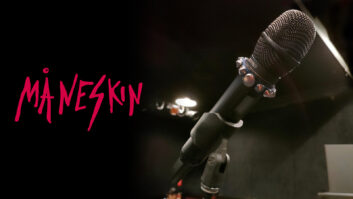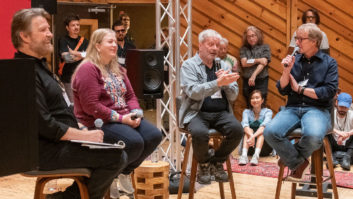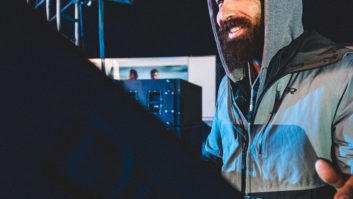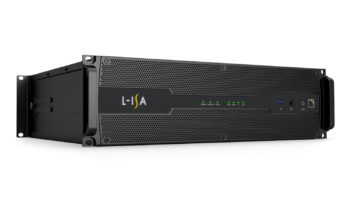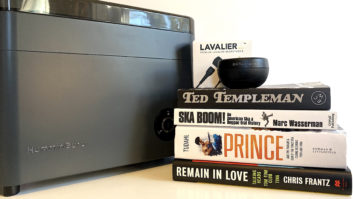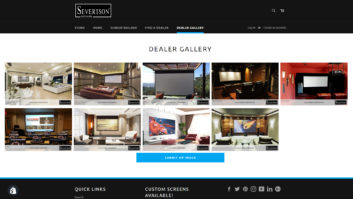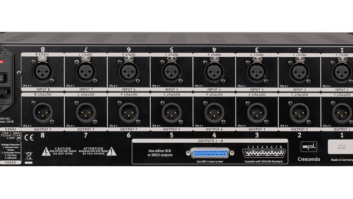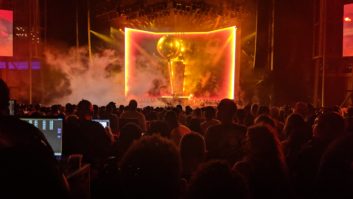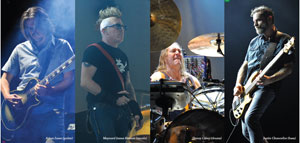
Tool, from left: Adam Jones, guitar; Maynard James Kennan, vocals; Danny Carey, drums; Justin Chancellor, bass
Photos: Steve Jennings; collage: Todd Berkowitz
In mid-March Mix took in an electrifying pair of sets along with a packed house in San Francisco’s Bill Graham Civic Auditorium from Los Angeles’ powerhouse art-metal band Tool—Danny Carey (drums), Justin Chancellor (bass), Adam Jones (guitar) and Maynard James Keenan (vocals). This was one of two shows in BGCA from the quartet amid a brief West Coast tour, which sees Tool reemerge for the first time since the summer of 2010. Although this tour does not support an album release and Tool has not introduced new material, rumors have been circulating in early 2014 about a possible new album release.
The band treated longtime and new fans alike to songs drawn from across its catalog, spiced up with some new arrangements, musical surprises, Carey’s debut performance on a modular synth rig, and moments of improvisation. Additionally, Tool stepped up the visual component of their show, creating an intense stream of jarring, nightmarish computer-generated imagery accompanied by laser beams and occasional confetti blasts in order to fully immerse the audience throughout each set.

Front-of-house engineer Alan “Nobby” Hopkinson mixes Tool on an analog Midas XL4 (at left) and a Midas PRO2C for overflow channels.
Photo: Steve Jennings
“The visual element is always at the heart of this show,” says veteran front-of-house engineer Alan “Nobby” Hopkinson, “obviously with audio being the silk stitching to complete the purse! Ha. We try to position audio to facilitate what the video and lighting departments are trying to create. All three departments have worked together for the 13 or 14 years I’ve been here—some [for] longer—so we have a pretty good understanding of each other.” Hopkinson has been involved with live sound since forming a small P.A. company with his friends and band mates that served the punk rock community in London circa 1980, and joined Tool’s audio crew after mixing Rage Against the Machine for their Battle of Los Angeles world tour in 1999 and 2000.

The P.A. system is a d&b audiotechnik J-Series line array.
Photo: Steve Jennings
Tool is carrying full production for these West Coast dates—including mics, in-ear monitors and a custom-built rack of outboard gear—and Eighth Day Sound is providing the audio system. The P.A. system is a d&b audiotechnik J-Series line array. The main hang comprises 16 J8 and four J12 loudspeakers, and six J-Sub cardioid subwoofers per side, while the side hang comprises 12 J8s and four J12s per side. Eighteen supplemental B2 subwoofers on the floor help deliver and enhance the band’s thunderous aural assault. “We carry enough P.A. to beat the crowd hands down, so there is no fight [with excessive audience noise]!” Hopkinson says.
Hopkinson mixes Tool on a Midas XL4 analog console and also carries a Midas PRO2C to handle overflow channels and mix the opening acts. Hopkinson mentions that he tried mixing Tool on a Midas PRO9 digital console “a couple of years ago but somehow couldn’t get the ‘Tool’ sound out of it. I mix many other bands on digital consoles, but [digital consoles] just didn’t sit right in this camp. So I went back to the XL4 and all the associated gates, comps and FX you have to bring along, too.” The FOH rack includes a dbx 120XP Subharmonic Synthesizer, two TC Electronic Dynamic Digital Delays, Eventide Ultra-Harmonizer, Yamaha SPX900 and Lexicon 224X Digital Reverberator.

Tool at the Bill Graham Civic Auditorium in San Francisco in March 2014
Photo: Steve Jennings
Although lead vocalist Keenan literally eschews the spotlight and positions himself in an unlit space on the drum riser to stage left of Carey’s drum set, fans expect to hear and understand the song lyrics, and the nuances of his vocal performance. Hopkinson says that Keenan recently began using a Telefunken M80 and that his vocal channel is “quite effected in places—some modulation, some harmonizing, some delays, a small amount of compression through the Avalon 737sp. His vocal is supposed to kind of sit in with the music, not always stand out above. It can be extremely difficult in particularly ambient halls to get [Keenan’s vocals] above the band’s level.
“All guitar channels are summed through a pair of groups at FOH and fed through a pair of dbx 160A [compressor/limiters] just to keep a hand on them,” Hopkinson says. Guitar and bass cabinets are miked with Heil PR 40s and PR 30s, with a Heil PR-31BW on Jones’ Marshall cabinet. Carey’s massive drum set sees SM57s (snare and rack toms), PR 40s (floor toms), Beta 91A and PR 48 mounted inside the kick drums; overheads/cymbals take AKG 414s and 451s, and Audio-Technica AT4050s.

Monitor engineer Beau Alexander mixes on a DiGiCo SD7.
Photo: Steve Jennings
Monitor engineer Beau Alexander joined Tool in 2006, just prior to the release of the band’s 10,000 Days album, as an independent engineer following five years working for Clair Brothers. “For this tour we are carrying a DiGiCo SD7 console with d&b wedges and side fills,” Alexander says. “Maynard is currently the only person on ears and he is using JH Audio earpieces with Sennheiser G3 transmitters. For Danny we have a left and a right stack of two d&b Q subs and a single top. Justin has two d&b M2s in front of him and one J-Sub with a single J8 top to the left of him. Adam has three d&b M2s in front of him and a J-Sub with a single J8 top to the right of him.
“Each band member likes to hear a mix of everything going on,” Alexander continues. “Each song may vary a little: a little more of this, little more of that, depending on what they are playing. I mix everyone who is on wedges pre fader and mix the in-ears post fader on the VCAs. We are using an onboard reverb and two bass chorus [effects] for some vocal effects.”
How do you deal with the stage volume and crowd noise? “We make it louder,” Alexander replies. “Ha. Our stage volume is pretty substantial. We all do a great job of working together.”
